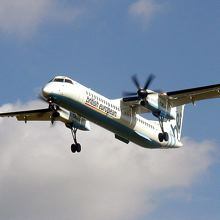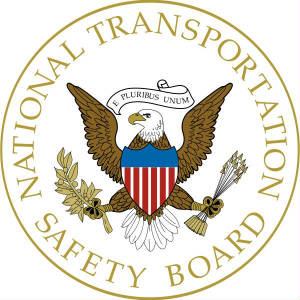 Officials are continuing the investigation of the crash of Continental Airlines Flight 3407.
Officials are continuing the investigation of the crash of Continental Airlines Flight 3407.
It was en route from New York to Buffalo when it disappeared off the radar screens about five miles short of the runway and crashed into a house.
The preliminary investigation shows that, as caught on voice recorder, the pilots were talking about “significant build-up of ice on the wings.”
This is an interesting airplane—the Dash 8 Q400 which I have talked about before. This plane, built by Bombardier in Canada, is a turbo prop.
What’s interesting about this particular plane is even though it has a sterling safety record—never has it had a record of having a crash—it has had a number of crash-landings.
You may remember back in November of 2007 we talked about the experience of the Scandinavian Airline System (SAS) with this plane. In particular, the problem was with the landing gear which had a nasty tendency of collapsing upon landing. Nobody was ever killed, thank God, but the plane was taken out of service by SAS. And at the time the airline did an unprecedented thing: They made the announcement that they would not only ground the fleet of these Dash 8 Q400, but also that they would never fly them again.
Now we have a different situation here, as it was a weather situation en route between New York and Buffalo. In fact, I was trying to fly that day, but my flights were canceled—one after another—because of the high-wind situation and the very unstable weather conditions in the New York area.
 Peter then spoke with Greg Feith, former National Transportation Safety Board (NTSB) lead investigator:
Peter then spoke with Greg Feith, former National Transportation Safety Board (NTSB) lead investigator:
PG: So right now, at least for starters, they are able to get very good data from that voice recorder, and the preliminary implications is that ice buildup on the wings was weighing this plane down.
GF: That is very true Peter, the NTSB has released a lot of information pretty early on which I was very surprised about. But all roads look like they are leading towards an icing event. Still, we have to be cautious because a lot of people are drawing a lot of similarity between this and that accident I investigated back in 1994 with the American Eagle Flight 4184. That was an ATR72 that crashed because of an icing event in Roselawn, Indiana.
PG: But that particular incident, Greg, I remember hearing about was at a much higher altitude.
GF: It was. The airplane was at 10,000 feet accumulating ice. The crew was doing what they were supposed to do: They were monitoring the ice; they turned on the ice protection system; they were shading the ice as they thought the system was doing.
Unfortunately, what they didn’t know was that because of the type of ice that was building up, it was building up behind that protective surface of the boot so they still had ice on it. It created a disruption of the airflow over the airplane and it literally stalled and came out of the sky.
PG: Now you mentioned the boot, which we should talk about.
GF: A de-icing boot is an interesting invention on these particular types of planes. It’s sort of a rubberized system within the wing that can expand and contract. It’s literally like gluing a balloon to the leading edge of the wing and when the crew sees ice building up on the leading edge they push a button and the boot expands. The ice cracks off and then once the cycle is done then the boot relaxes and maintains the smooth couture of the wing.
PG: But when you’re at 2,300 feet or lower, which this particular plane was, you don’t have a lot of margin for error.
GF: You don’t, and this crew had reported this icing at a significantly higher altitude. That leads me to wonder … you know they were accumulating ice in the en route phase or the initial decent phase. They were probably cycling the boots at that point, but apparently they were still carrying some residual ice with them as they got down to around the 2,300-foot altitude. So when they reconfigured the airplane, put flaps down and the landing gear down, that’s when the aerodynamic problems occurred similar to Roselawn. And the airplane went into an uncontrolled pitch maneuver and a roll maneuver and from 2,300 feet, like you said, you do not have a lot of margin of error.
PG: If I’m to believe what the sequence of events was right after that, we see that they crew on the plane knew they had a problem. They knew what was happening while it was happening, and before that plane ever even hit, apparently they attempted to raise the landing gear.
GF: They tried to raise the landing gear and the flaps. One of the things about being a pilot is when you do something to an airplane, like putting the landing gear or flaps down, that if it starts to create a problem, you go back to the configuration where the problem wasn’t occurring. And it sounds like that’s what these folks were trying to do: As soon as they configured the airplane, gear down, flap down, the airplane started to roll. They go “uh oh, it was flying normal before this” so they tried to get the gear and the flaps back up, but again, you’re running out of 2,300 feet of altitude very, very quickly.
PG: I should also add that after that ATR incident in Indiana that you investigated, American Airlines which operated that plane, made a decision on a fleet-wide basis to move all of their turbo prop operations—meaning every single turbo prop they moved to bases in San Juan, Miami, Fort Lauderdale, and to the West Coast where the icing situation is not that prevalent.
GF: Exactly and that helped until we could understand what was going on with the ATR72. And in fact, the French builder ended up extending the size of the boot to cover more of a wing area to try and prevent that buildup of ice in these unprotected areas from happening again.
It’s still very early in the game. The NTSB sends go teams to the area, and it’s not just one team. It’s a team made of metallurgical experts, human factor experts, engine experts. Every facet that can go into an operation of the plane has a team member expert assigned to it. What they try to do immediately is get the cockpit voice recorders, which they have done. And then it’s a matter of ruling things out, one by one, before they can rule anything in.
We have just gone through two and a half years of no fatal crashes on a commercial airliner in the U.S. That is amazing. But as opposed to other incidents we have investigated, we’re getting information rather quickly. In this particular case, I caution everyone that we don’t officially know, but the preliminary indications are that it was ice on a turbo prop. Which raises some other interesting questions. In the past, there have been turbo prop incidents and fatal incidents involving ice.
By Peter Greenberg from Peter Greenberg Worldwide Radio.
Previous coverage of the crash of Flight 3407:
Read more about air travel in our Airlines & Airports section.
Learn more about keeping safe with our Travel Safety & Security category.












